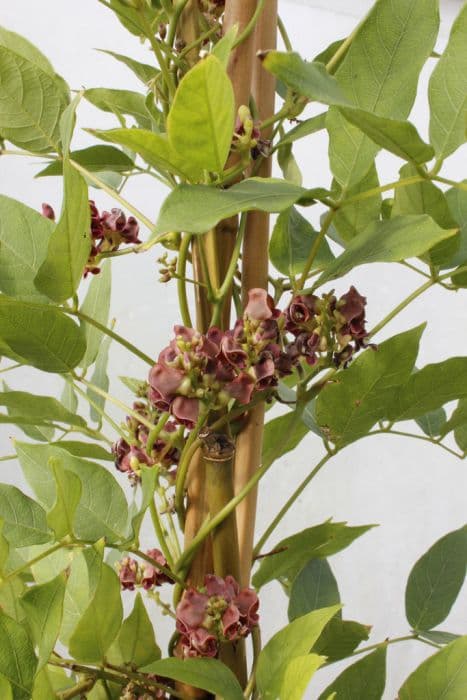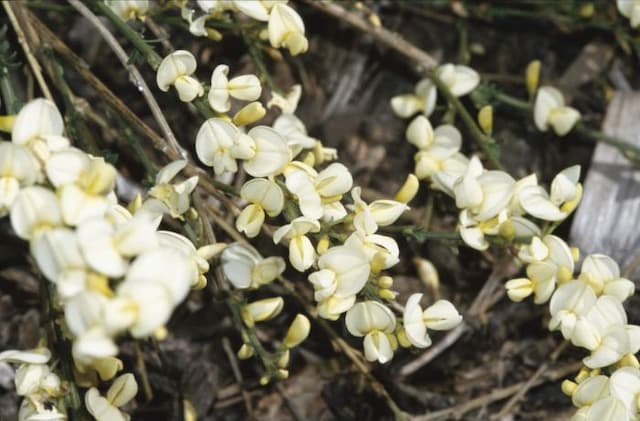David's Mountain Laurel Sophora davidii

ABOUT
The plant commonly known as David's Mountain Laurel or David’s Sophora is a decidentially shedding shrub with an attractive growth habit. It features a multitude of branches that spread outwards and are often covered with a rough, grey bark. The foliage is composed of elongated leaves that are pinnately divided (meaning the leaflets are arranged on either side of a common axis). These leaflets are small, oval to lance-shaped, and have a shiny green upper surface, while the underside is paler. During its blooming period, the plant is adorned with clusters of pea-like flowers. The blossoms are typically a striking blue-purple color, which adds a vivid splash of color to the green backdrop of the foliage. These flowers are followed by pod-like fruits that mature to a brown color. The pods are elongated and contain several seeds within them. Overall, David's Mountain Laurel has a bushy and rounded appearance, with its flowers providing a noticeable contrast against the foliage. It has a graceful and slightly arching form, making it an attractive choice for garden landscapes and natural areas. The foliage, flowers, and fruit pods all contribute to the visual appeal of this plant throughout its growing season.
About this plant
 Names
NamesFamily
Fabaceae
Synonyms
David's Mountain Laurel, David's Pagoda Tree
Common names
Sophora viciifolia, Sophora viciifolia var. davidii.
 Toxicity
ToxicityTo humans
The plant commonly known as David's Mountain Laurel (Sophora davidii) does contain compounds that can be toxic if ingested in significant quantities. While there is not a great deal of well-documented cases of human poisoning, members of the genus Sophora are known to contain alkaloids such as matrine and sophoridine, which could potentially cause harmful effects if consumed. The symptoms of poisoning could include nausea, vomiting, dizziness, respiratory issues, and in severe cases, could affect the central nervous system leading to complications such as convulsions or coma. It is advisable to avoid ingesting any part of the David's Mountain Laurel and to consult medical professionals if exposure occurs.
To pets
David's Mountain Laurel (Sophora davidii) can be toxic to pets if ingested. The Sophora genus comprises plants that contain potentially harmful alkaloids, such as matrine and sophoridine. These compounds can cause various symptoms in pets, which may include vomiting, diarrhea, lethargy, and in severe instances, respiratory distress or central nervous system effects, which could include tremors or seizures. If a pet ingests any part of the David's Mountain Laurel, immediate veterinary attention is necessary to manage the toxicity and prevent more severe health consequences.
 Characteristics
CharacteristicsLife cycle
Perennials
Foliage type
Deciduous
Color of leaves
Green
Flower color
White
Height
6-10 feet (1.8-3 meters)
Spread
6-10 feet (1.8-3 meters)
Plant type
Shrub
Hardiness zones
5
Native area
China
Benefits
 General Benefits
General Benefits- Landscape Ornamentation: Sophora davidii, commonly known as David's Mountain Laurel, offers aesthetic appeal with its lush, green foliage and clusters of pea-like flowers that can enhance the visual attractiveness of gardens and parks.
- Biodiversity Support: The flowers of David's Mountain Laurel attract various pollinators, such as bees and butterflies, contributing to the ecological health by supporting biodiversity.
- Erosion Control: With its robust root system, David's Mountain Laurel can be used to stabilize soil and control erosion on slopes and in areas susceptible to soil degradation.
- Drought Tolerance: David's Mountain Laurel is known for its ability to withstand periods of drought, making it a suitable choice for xeriscaping and water-conserving landscapes.
- Cold Resistance: As a hardy plant, David's Mountain Laurel can survive in cold climates, offering year-round greenery even in regions with harsh winters.
 Medical Properties
Medical Properties- Anti-inflammatory: Sophora davidii has been traditionally used to alleviate inflammation.
- Antioxidant activity: The plant contains compounds that are believed to have antioxidant properties.
- Antibacterial: Certain extracts of Sophora davidii may have antibacterial effects against various microorganisms.
- Antifungal: It may also possess antifungal properties against certain fungal pathogens.
- Hepatoprotective: There is some evidence to suggest that Sophora davidii may offer protection to the liver.
 Air-purifying Qualities
Air-purifying QualitiesThis plant is not specifically known for air purifying qualities.
 Other Uses
Other Uses- Ornamental landscaping: Sophora davidii, or the Sophora tree, is often used in ornamental landscaping for its attractive foliage and profuse pea-like flowers which can enhance the aesthetic value of gardens and parks.
- Erosion control: Due to its extensive root system, the Sophora tree is sometimes planted to stabilize slopes and prevent soil erosion in vulnerable areas.
- Nitrogen fixation: Being a leguminous plant, it has the ability to fix atmospheric nitrogen, which can help improve soil fertility over time.
- Windbreaks and shelterbelts: The Sophora tree can be implemented in windbreaks or shelterbelts to protect crops and soil from wind erosion.
- Urban greening: Sophora davidii is suitable for urban greening projects as it is relatively tolerant of pollution and can help in greening cityscapes.
- Live fencing: Its dense growth habit allows it to be used as a living fence or hedge, providing privacy and reducing noise pollution.
- Bonsai: Some gardeners use Sophora davidii for bonsai due to its interesting structure and potential for artistic shaping.
- Dye production: The wood and flowers of the Sophora tree can be used to produce yellow dyes for textiles.
- Tanning leather: Extracts from the bark and pods are potentially useful in the leather tanning industry.
- Woodworking: The wood from Sophora davidii is durable and can be used in the making of small objects, tool handles, and furniture.
Interesting Facts
 Feng Shui
Feng ShuiThe Sophora davidii is not used in Feng Shui practice.
 Zodiac Sign Compitability
Zodiac Sign CompitabilityThe Sophora davidii is not used in astrology practice.
 Plant Symbolism
Plant Symbolism- Adaptability: Sophora davidii, commonly known as David's Mountain Laurel, is a resilient plant that can thrive in a variety of soil types and conditions, symbolizing the ability to adapt and prosper in different environments.
- Endurance: This plant has a robust nature and can withstand harsh conditions, representing the trait of endurance through challenging times.
- Growth: David's Mountain Laurel is a fast-growing plant, which symbolizes personal or spiritual growth and the rapid development of ideas or projects.
- Protection: In some cultures, plants in the Sophora genus are considered to provide protective qualities, symbolizing shelter and safety against negative influences.
- Purity: The white flowers of David's Mountain Laurel can signify purity and innocence, often associated with the cleansing of thoughts or intentions.
- Healing: Traditionally, some Sophora species were used for medicinal purposes, which can translate into a symbol of healing and physical or emotional recovery.
 Water
WaterThe David's Tree or Sophie's tree should be watered deeply to ensure that the water reaches the root zone. In the growing season, it typically requires watering once a week, with about 1 to 1.5 gallons per session, depending on the soil type and climate conditions. During hot spells or drought, watering frequency may need to increase. In the dormant season, reduce watering to every two weeks or when the soil feels dry a couple of inches below the surface. Always allow the topsoil to dry out slightly before watering again to prevent overwatering and root rot.
 Light
LightDavid's Tree thrives in full sun to partial shade. The ideal location is where it can receive at least six to eight hours of direct sunlight each day. If you're planting it indoors, place it near a south-facing window or where it gets bright but indirect light most of the day. Avoid deeply shaded areas, as insufficient light can lead to poor growth and reduced flowering.
 Temperature
TemperatureDavid's Tree prefers moderate to cool temperatures and can tolerate a range from 15°F to 85°F. It is winter hardy down to about 15°F but should be protected from frost in areas where temperatures drop below this point. For optimal growth, temperatures between 50°F and 75°F are ideal. Extreme heat above 85°F for prolonged periods may stress the plant.
 Pruning
PruningPruning the David's Tree helps maintain its shape and encourages healthy growth. Prune in late winter or early spring before new growth begins. Cut back any dead, damaged, or diseased branches and thin out the tree to allow light and air to penetrate the canopy. It's not necessary to prune every year; every 2 to 3 years will suffice unless you are shaping the tree or removing problematic branches.
 Cleaning
CleaningNot needed
 Soil
SoilThe Chinese Scholar tree prefers well-draining soil with a slightly acidic to neutral pH of around 6.0 to 7.0. A good soil mix could include loamy soil, coarse sand, and peat moss or compost to improve drainage and fertility.
 Repotting
RepottingChinese Scholar trees growing in containers should typically be repotted every two to three years to ensure adequate root space and replenish nutrients in the soil.
 Humidity & Misting
Humidity & MistingChinese Scholar trees are tolerant of a wide range of humidity levels, but they thrive best in moderate humidity conditions typical of outdoor environments.
 Suitable locations
Suitable locationsIndoor
Provide bright light, well-draining soil, and moderate watering.
Outdoor
Plant in full sun, use well-draining soil, and water deeply.
Hardiness zone
5-7 USDA
 Life cycle
Life cycleSophora davidii, commonly known as David's Mountain Laurel, begins its life cycle as a seed, often requiring stratification to break dormancy and germinate. After germination, seedlings establish a root system and produce their first set of true leaves, entering the vegetative growth stage where the plant grows steadily in height and foliage. Following the vegetative stage, the plant reaches maturity and enters the flowering phase, producing inflorescences with clusters of purplish-blue pea-like flowers that are attractive to pollinators. Once pollination occurs, the flowers develop into pods containing several seeds, marking the reproductive stage. The pods eventually dry and open, releasing the seeds into the environment to start a new generation. Throughout its life span, which can be several years, David's Mountain Laurel may undergo periods of dormancy during colder months, resuming growth in the spring.
 Propogation
PropogationPropogation time
Spring
The most popular method of propagation for Sophora davidii, also known as the David's mountain laurel, is through seeds. The best time to sow seeds is in spring after a period of stratification to break dormancy. This typically involves placing the seeds in a moist medium such as sand or peat and storing them in a refrigerator at about 40 degrees Fahrenheit (4.4 degrees Celsius) for a duration that can range from one to three months. Once stratified, seeds are sown in a light, well-draining soil mix. It's crucial to keep the soil consistently moist but not waterlogged. Seedlings will typically emerge in a few weeks to a couple of months, depending on growing conditions. After the seedlings have developed their first set of true leaves and are large enough to handle, they can be transplanted into individual pots to grow on before being planted out into their final positions.









